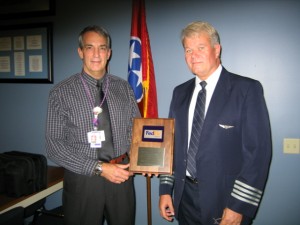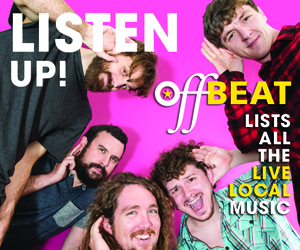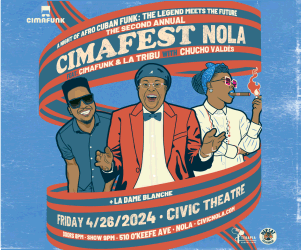 “Depending on your age, I’m an obscure celebrity, but more and more younger people are getting excited over old films that are considered cult films now,” Arch Hall, Jr. explains. “Some of mine have been pigeonholed into that classification.”
“Depending on your age, I’m an obscure celebrity, but more and more younger people are getting excited over old films that are considered cult films now,” Arch Hall, Jr. explains. “Some of mine have been pigeonholed into that classification.”
Hall was a teenager when he starred in a number of independent films in the early 1960s, films that have gone on to become cult classics. Three of those films, Wild Guitar (1962), Eegah! (1962) and The Sadist (1963) will be screened Saturday at the Ponderosa Stomp’s Clandestine Celluloid film series at the Renaissance Arts Hotel starting at 11 a.m. Later that night, Arch Hall, Jr. and the Archers will perform at the Stomp at the Howlin’ Wolf.
His stories about the making of those movies are looks inside a Hollywood that doesn’t exist anymore.
I didn’t realize that you were a guitar player before you started making movies.
I’m a self-taught guitar player since my dad had guitars sitting around. He was in Westerns and things back in the ’30s with John Wayne and Crash Corrigan, all those guys. There was always an old acoustic guitar around. I got into electric guitar at 11 or 12, and grew into that, got mesmerized by what I was hearing on AM radio stations. People like T-Bone Walker just fascinated me; the sounds he made baffled me for a long time. Big heavy strings like that, bending them, you just can’t figure out how he’s accomplishing that when you’re just a kid and you don’t have a lot of hand strength.
Did you play in bands growing up?
I got into a band of sorts around the Burbank/Fairway film compound. It was a parallel sort of universe—filmmaking and the band. We played clubs in the Greater Los Angeles/Hollywood area. At that time, there was experimentation in teenage nightclubs. They were trying to aim clubs at young people. They didn’t serve alcohol but had entertainment and cover charges. None of them really made it, but they were some exciting times.
How old were you when you first played for an audience?
We were around 14 or 15. I played in a duo with Deke Richards, of Motown fame. As far as the whole band playing clubs, that didn’t happen until we were older. We played some of the most infamous places, too, like the Whiskey A Go-Go and Pandora’s Box. Someone recently sent me a picture of our names up on the marquee along with Dobie Gray (“Drift Away,” “The In Crowd”), who used to be with my band as well. Arch Hall, Jr. and the Archers with Dobie Gray.
You mentioned Fairway—that was your dad’s studio?
It was the name tagged on a production company, and it was synonymous with a compound on the corner of Olive Avenue and Lincoln Street in Burbank, just down the street from NBC Studios. It still contains many people working in the film industry and television and looks very much the same. It had lots of little offices and such, and at one time was pretty much taken over by operations under my dad’s company, Fairway International Films. That became headquarters, ground zero, for all the film-making.
The Choppers—that was your father’s first film?
That was his attempt at getting back into the movie business after he got out of it in the ’30s and ’40s as an actor. He always liked it, but he got into all sorts of other things, like radio and the savings and loan business. I think he wanted to get back into the creativity he loved. He wanted to be a big fish in a little pond, so he started an independent production. He started with The Choppers in 1959. The problem with The Choppers was that there were no single openings with distributors. It was, for lack of a better word, crooked how they handled independent producers in those days. If you didn’t have something that could stand as its own billing—in other words, another movie to accompany it—they didn’t want just one. You could get together with another independent producer, that could work. But in his case, he came up against a brick wall. That’s how the next movie, Eegah!, was born. The Choppers actually stayed on the shelf until 1961. At that time I was 15, the age you can get a driver’s license, and I was in seventh heaven driving a hot rod featured on the cover of Hot Rod Magazine.
You got a lot of cool cars and bikes in your movies.
I had a lot of things that I built up. My friend Al Scott, he’s in Wild Guitar, we bought an old ‘47 Indian Chief motorcycle from an old lady in Indio for five dollars if we’d haul it away. We worked on it, fixed it, finally got it going. Had a couple of bad spills on it trying to figure out how to control the damn thing. It would go to full throttle on us, couldn’t get it to slow down. I used to ride an old Harley flathead to school, a World War II thing. It was always engines and grease. There was a time I thought that it would be great to be a grease monkey. I still have a Harley.
[youtube]http://www.youtube.com/watch?v=2sbHcm0xED0[/youtube]
Does everyone ask you about the dune buggy in Eegah!?
Sometimes. That dune buggy started life as a 1939 Plymouth sedan that was cut. The body was removed, the driveshaft was shortened and then it was welded back together. But it was done in a Mickey Mouse way, gas welded, so under the stresses of coming over dunes and landing hard, the frame broke on me twice during the making of Eegah!. One time it pinned me in the thing and I couldn’t get out. They had to get a huge bumper jack and put it on the windshield frame and the doorjamb to pull that apart. Until they got the jack hooked up, there were three or four guys pushing as hard as they could with their legs to keep it off of my chest, I couldn’t breathe. Of course, they welded it again with gas. We didn’t learn anything. I don’t think Richard Kiel [the actor who played the title character] would get in it. He was too smart [laughs].
Was this Richard Kiel’s first movie? [Kiel’s best known for the role of Jaws in the James Bond film The Spy Who Loved Me.]
It may have been. It was certainly the one that everyone heard about. It made the drive-in movie circuit.
How was he cast?
I think Richard came to interview with my Dad for a proposed treatment called Striganza, which was never made. It was very strange, and Richard really didn’t like it. There was cannibalism, half-animal-people, stuff from the Island of Dr. Moreau. But my Dad, not wanting to lose this guy with his incredible physique and presence, started thinking fast. He’s scribbling on this yellow pad, saying, “That’s not necessarily the thing we have to do next. How about a prehistoric giant lost through the centuries, and he ends up surviving in the mountains above Palm Springs and he falls in love with a girl. What do you think?” and Richard sort of nodded his head. At least it’s better than cannibalism and half-animals. And that’s how it all began. We shot it in Palm Springs, Palm Desert, some of the interiors were in Burbank.
I read that some of the desert land you were filming on belonged to Harpo Marx?
Yeah, actually, he came down. Ray Dennis Steckler [who was the assistant cameraman on the film] was standing there, and Harpo Marx came up and tapped him on the shoulder. He turned around and recognized Harpo, who said “What’s going on here?” We were of course shooting without police permits and things. And Ray was great, he says, “Well, it’s an educational film for UCLA,” or something, but Harpo doesn’t buy it. He knew who we were, but he stopped there, wished us luck, and walked away. We were totally wrong to be on his property, but he was very nice.
[youtube]http://www.youtube.com/watch?v=sZZT7p2bj2I[/youtube]
Steckler directed Wild Guitar, didn’t he?
Yes, and he acted in it, as a villain.
In the movie’s opening sequence, that’s you walking down through Hollywood without shutting the street?
We just went and did it. We didn’t have any permits or anything. We did it in Malibu too. We usually had the “It’s easier to beg forgiveness than to ask permission” attitude. That may not be as easy to do today, but we would get ready like a special operations force. We would attack and immediately people would start to notice, and in the hour it would take for a police car to show up, we were done. We usually got off scott-free.
Did you or your dad ever have to talk your way out of trouble with the cops?
Oh, yeah. We’d do things like driving the hot rod too fast and cops would be watching from an upper highway and they would come down. “How fast were you going?” and I’d respond 40 or 50, when it was more like 95. But they didn’t have radar, and in most cases they were helpful. Frequently they didn’t understand what we were doing.
Actually, we had more trouble with unions. These were non-union productions, and later on, unions would come and try to beat people up or steal the film. When we were filming Eegah! in a warehouse on Santa Monica, we’d been there for 42 hours, and people were so tired they were almost starting to hallucinate. We had made the most godawful mess. We’d spread black graphite everywhere because it was cheap, but it’s toxic and makes a huge mess. It was on our faces and our clothes, in our nostrils and ears. Outside it’s 3:30 in the morning and Ray is changing magazines in the camera, and these union goons show up. They start saying they’re going to break our legs, but Ray manages to keep them at bay. They say they won’t leave without the film, the raw negative. So he gives it to them, and they throw it on the ground and spit on it. But he had actually given them the unexposed magazine; he kept the magazine we needed in the camera!
I’m not anti-union. I’ve been in musicians’ unions and airline pilots’ unions for years. But at that time it was tough.
What do you remember about shooting the beach scene at the end of Wild Guitar?
That was done pretty quick. It was my friends and girlfriend at the time. We picked up some people at Bob’s Big Boy in North Hollywood. We didn’t waste any time at it. We were in and out.
To go back to the opening of Wild Guitar for a minute, if you were doing everything guerrilla fashion, does that mean that when your suitcase falls open in the street, you really did just stop traffic?
Yes [laughs]. Absolutely.
Another thing about low budget films is that we frequently used live ammunition. We’d only use blanks if there was a real reason to use blanks. But if we were shooting at something, something supposed to be hit, we would use live ammunition. In The Sadist, we used live ammunition. It was carefully orchestrated, of course, and the actors were agreeable. We would watch the angles, but when I was firing through boards behind Richard Alden, those were live rounds tearing through boards three feet behind him.
[youtube]http://www.youtube.com/watch?v=4Tfnwvqeydo[/youtube]
When you mentioned live ammo, it made me think of the scene in The Sadist where you shoot the tire out. The guy looks like he’s only four feet away from the tire when you shoot it.
There was another time, when we were having trouble with a wax pneumatic rifle that was supposed to fire a black soft wax pellet that they said would give the appearance of a bullet hole in glass. It was bullshit. It wasn’t working at all. We had to fall back to something. In the scene, the schoolteacher is supposed to be immediately below this pane of glass that gets shot to taunt him. We were stymied. You can’t pretend there’s a bullet. So my dad says, “Look, we can fire something that’s really precise like a rifle. I’m an old cowboy, a real good shot, and if the actor is comfortable with it, I guarantee there’s no problem.” The guy who owned the property we were shooting on was a rancher, so we asked him if he owned a rifle. He had a .300 Winchester Magnum. It had a scope, but my Dad took that off because there was parallax error in using a scope at that short a distance, and he sat right to the side of the camera. The director tapped my dad on the shoulder when they wanted him to fire. He fired a .300 Winchester Magnum above, and that’s a supersonic round when it comes out of the muzzle at something close to 3,000 feet per second. The shock wave and muzzle blast got a tremendous response from the actor. Not much acting really; it’s a shock to be on the business end of a .300 Win Mag.
I know there have been a number of tragedies on film sets, and now they’re much more careful, but you have to understand that we were all firearm-oriented people. There was an element of control to it, even though it sounds insane by today’s standards.
Where did you shoot The Sadist?
That was shot in an area north of Newhall-Sawgus which was near where the 405 turns into the 5 and goes up to Bakersfield. It was off to the east of that. I understand now that the actual location is condominiums and tennis courts. Actually that wasn’t a junkyard; all of those cars were hauled in on trucks. It was dressed to be a junkyard, pretty convincingly too.
Did you rent that property, or just find some agreeable people?
There was an agreement that would let us use the ranch. That was with the owner, but his wife saw all of these old cars being hauled in leaking oil and rattlesnakes and things like that—she thought we were idiots. But in the end, the agreement worked out. There was a cleanup crew. All the cars were hauled away.
Your performance in The Sadist was different from your previous movies. One of the things that impressed me was the physical change, you walked differently.
I used every scrap of guidance I could get from the director, James Landis. He wasn’t so sure I could do it. I didn’t have much acting experience. Landis had someone else in mind who was an accomplished actor, but my dad asked, “Don’t you think Junior’s got any possibility?” Jim would just make a face and shake his head: “I don’t know.”
Jim decided to work with me a little bit before making any final decision. He would give me direction to the extreme, down to the slightest nuance. Sometimes I would overdo it, and he’d laugh and have me take it down a few notches. Any success I had in that role is due to James Landis. It was a serious thing; it wasn’t Wild Guitar or something where you could just be likable. I had to be scary and vicious, attributes I had never thought of before—how to be an evil person.
Of those films, which had the biggest budget?
The Choppers, actually. It was shot full union, which caused problems that my dad didn’t understand. One time people were screaming for someone to move the hot rod on set, and I’m standing there, so I moved it maybe 14 feet. Then someone taps me on the shoulder and asks if I moved that car. I said, “Yes sir.” Then he walked over to the Assistant Director and said they were shutting it all down. He was with the teamsters’ union. They only agreed to come back and resume shooting if for the rest of the week there were triple crews on golden time to punish my dad. I felt horrible; I didn’t understand any of this. The cameraman looked at me, like, “I know, kid. I asked you to move the car and you moved it. But this is a movie set. Nobody touches the vehicle. If you’re supposed to drive the car in the movie, as an actor or extra, you’re allowed to touch the car. Outside of those circumstances, you’re in big trouble.” No one told me.
So Wild Guitar, Eegah!, and The Sadist were non-union. How long did those take to make?
It was a matter of weeks. It was not real fast. The Sadist is in real time as it plays on the screen, but it was shot out of sequence. It was handy that there was only one location. It was the fastest, maybe not the easiest.
We did things before there were Macintoshes and software; we didn’t even have the right equipment for the era, either. We were using office tape recorders, slowing the speed and playing it back into another recorder at a high speed. That’s how we got the low voice for Eegah!. The women’s restroom at the Fairway compound was an echo chamber. We had a microphone on one end and a speaker on the other. It was like MacGyver before there was a MacGyver. It was guerrilla filmmaking. It was all done with stuff you could buy in a hardware store.





